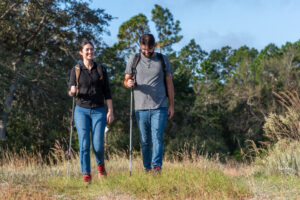Project DIRT: Water-Smart landscaping research
Keeping your lawn green doesn’t have to take a lot of water, but exactly how much is really needed to keep your landscape looking healthy?
That very question sparked Project DIRT, short for Doing It Right, a partnership between the St. Johns River Water Management District (District), the University of Florida (UF), Quality Trees and Shrubs, and Life Soils. Together, they’re studying how drought-tolerant landscape plants perform in different soil types and under limited irrigation to determine how little water healthy landscapes truly need.
The idea began with James Watson, president of Quality Trees and Shrubs, who recognized the region’s water supply constraints. Wanting to test drought-tolerant plants across Florida’s varied soils, with and without compost and limited irrigation, Watson reached out for help. Deirdre Irwin, a District water conservation coordinator, connected him with UF researchers led by Dr. Basil V. Iannone. With the right partners in place, Project DIRT took shape.
“At the end of the day, I want to be able to go to a new community, take a soil sample, match it with one of the soils from this study, and provide a plant palette that best suits that soil,” said Watson. “Ultimately, we want to know how little water these plants can use and still thrive.”
To test these conditions, the team established 72 test plots at Watson’s tree farm using different types of development soils found in Florida and planted a mix of commonly used drought-tolerant species, all donated by Watson. Each plot is being monitored, and over time, the data will reveal which soil and plant combinations perform best with the least amount of water. Life Soils donated the compost used in select test plots and will conduct several of the soil tests.
Even innovative ideas need practical support. When Watson found himself short on dirt, Irwin knew where to find it.
“Through other District programs, I learned of a project in south Lake County that actually had too much dirt,” Irwin said. “We arranged for three District dump trucks to haul the excess soil to Project DIRT. It was a perfect match.”
That small act of teamwork provided the missing piece to keep the research moving forward and could ultimately lead to lasting change in how Florida landscapes are designed and maintained.
The study is expected to take about two years, with UF researchers analyzing data collected over time. Master gardeners, UF students and Watson’s staff are all playing a role, from evaluating plant performance and monitoring the plots daily. The findings could help guide future landscaping practices and make it easier for developers, landscapers and homeowners to design beautiful, low-maintenance landscapes that conserve one of Florida’s most precious resources: water.
The District is proud to support this collaborative effort, helping turn truckloads of dirt into a valuable investment in Florida’s sustainable future.





